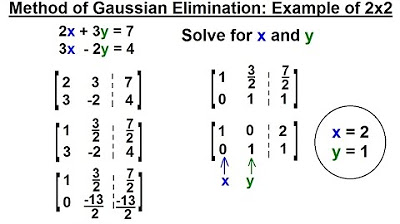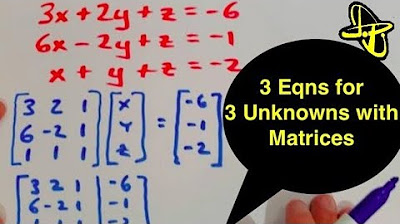PreCalculus - Matrices & Matrix Applications (10 of 33) Gaussian Elimination: Example of Solving 3x3
TLDRThe video script presents a step-by-step guide on solving a system of linear equations using the method of Gaussian elimination. The process involves creating an augmented matrix with coefficients of the variables and constants, and then systematically manipulating the matrix to achieve a diagonal of ones with zeros elsewhere. The final row operations yield the values for x, y, and z, which are the solution to the given equations. The method is detailed with clear explanations and is referred to as the 'giian elimination method' by the speaker.
Takeaways
- 📌 The video discusses solving a system of linear equations with three variables (x, y, z) using the method of Gaussian elimination.
- 🔢 The process starts by forming an augmented matrix with the coefficients of the variables and constants from the equations.
- 🎯 The goal is to manipulate the matrix so that the diagonal elements are ones and all other elements in the same rows and columns are zeros.
- 🔄 Row interchanges are performed to move the largest coefficient to the diagonal position to avoid fractions.
- 📉 Rows are then scaled and added or subtracted from each other to create zeros in the columns below the diagonal.
- ✅ The process is repeated for each column, ensuring that only one non-zero entry remains in each column.
- 🔢 After completing the elimination process, the values of x, y, and z can be read directly from the matrix.
- 🌟 The video emphasizes the importance of keeping track of the row operations to correctly solve for the variables.
- 📚 The method of Gaussian elimination is a powerful tool for solving systems of linear equations and finding the coordinates where three planes meet in space.
- 👍 The video demonstrates a step-by-step approach, making it easier for viewers to understand and follow the process.
- 💡 The final result provides the values of the variables that satisfy all three equations simultaneously.
Q & A
What is the main topic of the video?
-The main topic of the video is solving a system of linear equations using the method of Gaussian elimination.
What is an augmented matrix?
-An augmented matrix is a matrix that consists of the coefficients of the variables in a system of linear equations, along with the constants from the right side of the equal sign, used to help visualize and solve the system.
What is the goal of Gaussian elimination?
-The goal of Gaussian elimination is to manipulate the augmented matrix into a form where the diagonal elements are 1s and all other elements in the corresponding columns and rows are 0s, making it easier to read off the solution values for the variables.
How does the speaker decide which row to start with in the Gaussian elimination process?
-The speaker decides to start with the row that does not contain fractions or decimals to avoid complications early in the process.
What operation did the speaker perform to get a 1 in the upper left corner of the matrix?
-The speaker performed a row interchange, swapping row one with row three, to get a 1 in the upper left corner of the matrix.
How does the speaker eliminate variables from the second column?
-The speaker eliminates variables from the second column by using back-substitution, where they replace rows with calculations involving the 1s in the diagonal and add them to other rows to get zeros above and below the 1s.
What does the final matrix look like after the Gaussian elimination process is complete?
-The final matrix has 1s down the diagonal, with 0s in the positions directly above and below each 1, and the solution values for x, y, and z are found in the columns corresponding to these 1s.
How does the speaker interpret the final matrix to find the values of x, y, and z?
-The speaker interprets the final matrix by looking at the columns with the 1s and reading the values in the last row, which correspond to the values of x, y, and z.
What is the solution to the given system of linear equations based on the video?
-The solution to the given system of linear equations is x = -2, y = 1, and z = 3.
Why is it important to have a 1 in each diagonal position during the Gaussian elimination process?
-Having a 1 in each diagonal position simplifies the process of eliminating variables and allows for easy back-substitution to find the solution values for each variable.
What is the method of elimination also referred to by the speaker?
-The speaker also refers to the method of elimination as the 'giian elimination' method.
Outlines
📚 Introduction to Solving Systems of Linear Equations
This paragraph introduces the method of Gaussian elimination for solving systems of linear equations. It explains the process of finding values for variables x, y, and z that satisfy all three equations by arranging the coefficients of the variables in an augmented matrix. The goal is to manipulate the matrix so that the diagonal elements are ones and all other elements in the same row are zeros, which will then allow for the determination of the solution. The paragraph outlines the initial steps of this method, including the interchanging of rows and the use of operations to achieve the desired matrix form.
🔢 Elaboration on Gaussian Elimination Steps
This paragraph delves deeper into the specific steps of Gaussian elimination, detailing the row operations required to transform the augmented matrix. It describes how to achieve a matrix with ones along the diagonal and zeros elsewhere by using multiplication and addition of rows. The paragraph also explains how to deal with fractions and decimals that may arise during the process. It concludes by showing how the final form of the matrix allows for the extraction of the solution values for x, y, and z, thus solving the system of linear equations using this method.
Mindmap
Keywords
💡Gaussian Elimination
💡Augmented Matrix
💡Coefficients
💡Variables
💡Linear Equations
💡Solutions
💡Row Operations
💡Diagonal
💡Intersection
💡Constants
💡Planes
💡Interchange
Highlights
Introduction to the method of Gaussian elimination for solving systems of linear equations.
Explanation of how to use the coefficients of variables to form an augmented matrix.
The process of transforming the matrix to have ones on the diagonal and zeros elsewhere.
Interchanging rows to achieve a one in the upper left corner.
Using the first row to turn other elements in the same column to zero.
Transforming the second row to have a one in the middle column.
Multiplying entire rows by negative one to change signs and achieve a one in the middle column.
Using the second row to turn other elements in the middle column to zero.
Transforming the third row to have a one in the last column by dividing by the coefficient.
Using the third row to turn other elements in the last column to zero.
Final step of obtaining the values for x, y, and z by back substitution.
Solution of the set of linear equations using Gaussian elimination.
The practical application of finding the coordinates where three planes meet in space.
The importance of maintaining a systematic approach to solving complex mathematical problems.
The innovative method of visual separation of variables and constants in the augmented matrix.
The detailed explanation of each step in the Gaussian elimination process.
The use of the augmented matrix as a visual tool for solving systems of linear equations.
Transcripts
Browse More Related Video

PreCalculus - Matrices & Matrix Applications (7 of 33) Method of Gaussian Elimination: 3x3 Matrix*

PreCalculus - Matrices & Matrix Applications (5 of 33) Method of Gaussian Elimination: Example

Gaussian Elimination With 4 Variables Using Elementary Row Operations With Matrices

Gaussian Elimination & Row Echelon Form

PreCalculus - Matrices & Matrix Applications (6 of 33) Method of Gaussian Elimination: 2x2 Matrix

Solving 3 Equations for 3 Unknowns Using a Matrix in Row Echelon Form
5.0 / 5 (0 votes)
Thanks for rating: